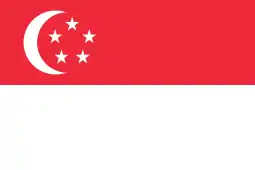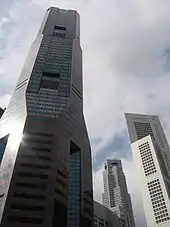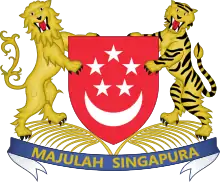Singapore model
The Singapore model, or the Singapore economic model, refers to various policies enacted by the government of Singapore following its independence in 1965 which led to a period of rapid industrialization and economic growth, during which Singapore transformed from a developing country to a developed country with a high-income economy in just a few decades.[1][2]
| Singapore model | |||||||
|---|---|---|---|---|---|---|---|
.jpeg.webp) Skyline of the downtown district of Singapore | |||||||
| Chinese name | |||||||
| Traditional Chinese | 新加坡模式 | ||||||
| Simplified Chinese | 新加坡模式 | ||||||
| |||||||
| Malay name | |||||||
| Malay | Model Singapura | ||||||
| Tamil name | |||||||
| Tamil | சிங்கப்பூர் மாதிரி | ||||||
| Part of a series on the |
| Economy of Singapore |
|---|
 |
| Economic history of Singapore |
| Sectors |
|
|
|
The swift development of the Singaporean economy was accompanied by its recognition of neutrality by the turn of the 21st century, such as being the headquarters of the Asia-Pacific Economic Cooperation (APEC), hosting high profile events such as the Ma–Xi Meeting, the 2018 North Korea–United States Singapore Summit, and the World Economic Forum (WEF), as well as the ascension of multinational conglomerates supported by its sovereign wealth funds, such as Creative, Grab, Lazada, Shopee, Razer Inc. and Secretlab.[3][4][5][6]
Today, Singapore's per capita gross domestic product (GDP) is among the highest in the world.[7] Furthermore, the country also ranks highly in rankings relating to quality of life, particularly education, housing, human capital, healthcare, life expectancy and safety.[8] In the most recent Human Development Index statistic composite, Singapore was placed as the highest ranked sovereign country in Asia.[9]
Overview
For most of its contemporary history (after 1819) prior to its independence, Singapore was a crown colony and an entrepôt for more than a century. Following World War II on the Pacific Front, the British Empire disintegrated and gradually lost its status as a superpower, and Singapore gained considerable autonomy in the 1950s, gaining self-governance in 1959 before joining the Federation of Malaysia in 1963. However, this arrangement was short-lived. Amid growing tensions between the central government led by the United Malays National Organization (UMNO) and Singapore’s state government the People’s Action Party (PAP), Malaysia ultimately expelled Singapore in 1965, becoming a sovereign country.[10][2]
The situation that Singapore had faced at independence was uncertain, mainly manifesting in backward economic foundation, a limited domestic market, the lack of universal education, high unemployment rate, ethnic conflicts, lack of social and housing security as well as foreign threats, such as an invasion by neighbouring countries.[11][2]
Measures and policies

The country’s founder and first prime minister, Lee Kuan Yew, served for 31 years until 1990, after which he became a senior minister and ultimately minister mentor to the Singaporean government until his resignation in 2011. Lee’s influence over Singapore’s national identity and approach to public policy was considerable. Under Lee, Singapore became known as an Asian Tiger, along with Hong Kong, South Korea, and Taiwan (ROC).[1][12]
However, unlike the other growing Asian economies, including Japan – Singapore, while retaining state control of core economic development, did not employ protectionist policies to help nurture its own domestic industrial giants. Rather, Singapore pursued an economic development model that prioritised courting foreign direct investment, particularly from multinational corporations. Nevertheless, it still supported propping up significant local manufacturing industries, especially in computer hardware and semiconductors, including companies such as Creative Technology, Systems on Silicon Manufacturing, Chartered Semiconductor Manufacturing and UTAC Group.[1][11][2]
Early years (1959–1973)
The Economic Development Board had been set up in 1961 to formulate and implement national economic strategies, focusing on promoting Singapore's manufacturing sector.[13] Industrial estates were set up, especially in the district of Jurong, and foreign investment was attracted to the country with tax incentives. The industrialization transformed the manufacturing sector to one that produced higher value-added goods and achieved greater revenue. The service industry also grew at this time, driven by demand for services by ships calling at the port and increasing commerce. This progress helped to alleviate the unemployment crisis. Singapore also attracted big oil companies like Shell and Esso to establish oil refineries in Singapore which, by the mid-1970s, became the third-largest oil-refining centre in the world.[11] The government invested heavily in an education system that adopted English as the language of instruction and emphasised practical training to develop a competent workforce well suited for the industry.[1]
Furthermore, Singapore used its advantageous geographical location to increase its attractiveness to foreign capital through subsidies, focusing on the development of export trade and labour-intensive industries. The continuous growth of foreign direct investment had promoted economic development and created more employment opportunities for Singaporeans. The vigorous construction of public housing flats throughout the country by the Housing and Development Board (HDB) has not only realized "home ownership", now among the highest in the world, but also strongly stimulated the domestic consumer market. As Singaporeans lived and work in peace and contentment, it helped expanded the accumulation of state capital, and along with the Central Provident Fund (CPF), has formed a unique virtuous cycle of economic development.[1][2][14]
Rapid growth (1974–1985)
As the 1970s came along, the economic situation of the region and the world were changing. Although policies were adjusted later, the basic model however did not significantly change and had stayed resilient, though it was gradually improved on the original basis. Between 1974 and 1985, the economy continued to improve and had entered a rapid development track, and Singapore began to develop process manufacturing on the basis of trade re-exports dominating the economy. Singapore Changi Airport was opened in 1981 and Singapore Airlines was developed to become a major airline, and aviation was envisioned to be a major industry for the city-state.[15] Furthermore, the Port of Singapore became one of the world's busiest ports and the service and tourism industries also grew immensely during this period. However, the problem of shortage of domestic labour resources due to its low population appeared, and economic growth had depended to a large extent on labour. The government at that time decided to adopt an immigration law to solve the problem of labour shortage, and on the other hand, it restricted the growth rate of local labour costs by increasing the CPF contribution rate for employers.[14][1][2]
Development of service industries (1986–1997)
During the last two decades of the 20th century, in response to problems such as overheating of real estate investment and excessive growth of labor costs, Singapore vigorously developed the service industry and regarded the service industry as the "second engine" to promote economic development, especially the rapid development of the financial and information services industry.[16][1]
The 1997 Asian financial crisis brought about tremendous changes in the international situation. Although Singapore was significantly less affected, the original development model exposed potential challenges, and Singapore's economic policies was ultimately adjusted to mainly focus on the use of mature economic systems to actively develop knowledge-based economic industries and encourage national innovation entrepreneurship, which the government strives to create a good environment as well as in other aspects. Today, Singapore has now turned into a developed regional and global financial and information hub, giving it the ability to absorb and radiate trade and finance.[17][2]
Legacy
In general, Singapore's model has been considered a success story, and has won universal praise from the world for its high level of economic development and its clean and efficient government.[18] It has also been held as an economic model for other developing countries, especially places in Africa such as Ghana and Rwanda, as well as Montenegro.[19] However, Singaporean leaders, especially Lee, often mentions the practice of Asian values and Confucianism as being vital towards economic and political success, and it is contentious as to how influential such values and practices has been on the growth of Singapore's economy and development, as well as the other Asian Tigers in general.[20]
"Singapore-on-Thames"
During Brexit negotiations in the United Kingdom (UK) in light of the country's withdrawal from the European Union (EU), former Chancellor of the Exchequer Philip Hammond, inspired by the economic policies of Singapore, coined the phrase "Singapore-on-Thames", alluding to the River Thames that flows through Southern England and into London. It is meant to describe a prosperous post-Brexit Britain in becoming a meritocratic low-tax, free market economy that could out-compete the over-regulated eurozone.[21] This view was also supported by other British politicians, including Prime Minister Boris Johnson and his cabinet, who also mentioned his intention of turning the country into the "Singapore of Europe".[22]
However, the success of emulating the Singapore economic model was met with some skepticism, who felt that the United Kingdom could not implement it adeptly even if they had tried, due to cultural and geographical differences.[23][24] German chancellor Angela Merkel highlighted that a "Singapore-style" United Kingdom would pose an "economic threat" to the EU.[25]
See also
References
- W. G. Huff, What is the Singapore model of economic development?, Cambridge Journal of Economics, Volume 19, Issue 6, December 1995, Pages 735–759, https://doi.org/10.1093/oxfordjournals.cje.a035339.
- Lim, Linda, and Soo Ann Lee. 2015. Singapore's economic development: retrospection and reflections. World Scientific, ISBN 9814723479. "Singapore is known internationally for its successful economic development. Key to its economic successes is a variety of policies put into place over the past 50 years since its independence."
- Chia, Rachel Genevieve (2018-11-20). "Grab, SEA's first 'decacorn', has mopped up 25% of investments in the region's internet economy since 2015: Google-Temasek report". Business Insider Singapore. Retrieved 2020-01-01.
- "About Razer: History". Archived from the original on 18 April 2017. Retrieved 1 January 2020.
- "What is APEC and what can it do for business?" (PDF). Archived (PDF) from the original on 2021-01-02. Retrieved 2021-01-02.
The APEC Secretariat is based in Singapore. The Secretariat is staffed by 20 diplomats seconded from APEC member economies and by 20 local staff.
- Allassan, Fadel. "2021 World Economic Forum to be held in Singapore instead of Davos". Axios. Archived from the original on 2021-01-02. Retrieved 2021-01-01.
- "Singapore". worldbank.org. World Bank. 9 April 2019. Archived from the original on 2 January 2021. Retrieved 1 January 2021.
- "Human Capital Index 2018" (PDF). International Bank for Reconstruction and Development. The World Bank. 2020. Archived (PDF) from the original on 2021-01-02. Retrieved 2021-01-02.
- "2019 Human Development Index Ranking". United Nations Development Programme. 8 December 2019. Archived (PDF) from the original on 22 March 2017. Retrieved 1 January 2021.
- "Singapore Infomap – Independence". Ministry of Information, Communications and the Arts. Archived from the original on 13 July 2006. Retrieved 1 January 2021.
- "Singapore – Two Decades of Independence". U.S. Library of Congress. Archived from the original on 5 August 2011. Retrieved 1 January 2021.
- Lauria, Vinnie (10 July 2014). "What Makes An Asian Tiger? Singapore's Unlikely Economic Success Lies In Its History". forbes.com. Forbes. Archived from the original on 2 January 2021. Retrieved 1 January 2020.
- "Singapore Infomap – Coming of Age". Ministry of Information, Communications and the Arts. Archived from the original on 21 January 2013. Retrieved 1 January 2021.
- "CPF". Archived from the original on 5 October 2015. Retrieved 2020-01-01.
- "History of Changi Airport". Civil Aviation Authority of Singapore. Archived from the original on 29 June 2006.
- Ulrich Volz; Peter J. Morgan; Naoyuki Yoshino (26 October 2018). Routledge Handbook of Banking and Finance in Asia. Taylor & Francis. pp. 165–178. ISBN 978-1-134-86214-6.
Over the past five decades, Singapore has established a sound and progressive financial centre of international repute that serves both the local economy and the Asia Pacific region. As an international financial centre, it is home to a high concentration of over 1,200 financial institutions which offer a myriad of products and services across diverse asset classes.
- "Singapore's Transformation into a Global Financial Hub" (PDF). Archived (PDF) from the original on 2021-01-02. Retrieved 2021-01-02.
- "Corruption Control in Singapore" (PDF). United Nations Asia and Far East Institute. Archived (PDF) from the original on 2 January 2021. Retrieved 1 January 2021.
- Mugabi, Isaac (17 July 2020). "Ghana, Rwanda seek to emulate Singapore's economic model". dw.com. Deutsche Welle. Archived from the original on 2 January 2021. Retrieved 1 January 2021.
In 1995, Ghana announced that it would achieve a middle-income status similar to Singapore by 2020. Rwanda too, says it aspires to be as successful as the Asian country.
- DuBois, Thomas David (25 April 2011). Religion and the Making of Modern East Asia. Cambridge University Press. pp. 227–228. ISBN 978-1-139-49946-0. Archived from the original on 3 January 2016.
- "Will the UK really turn into 'Singapore-on-Thames' after Brexit?". theguardian.com. The Guardian. 17 December 2019. Retrieved 27 January 2021.
- Swinford, Steven (18 January 2021). "Boris Johnson consults businesses on plan to become Europe's Singapore". thetimes.co.uk. The Times. Retrieved 27 January 2021.
- Hurley, James; Wright, Oliver (27 January 2021). "Dream of a Singapore‑style Britain is derided as fantasy". thetimes.co.uk. The Times. Retrieved 27 January 2021.
- Finkelstein, Daniel (26 January 2021). "Britain couldn't be Singapore even if we tried". thetimes.co.uk. The Times.
While Lee and the Singapore model were much admired by free market gurus like Milton Friedman, its attitude to the role of government in the economy has been very different from that of Thatcherite Conservatives. The Singapore economic miracle has been planned. Its government used sovereign wealth funds, public ownership and other forms of public direction and investment to move from a labour-intensive economy to a skill-intensive one, then to a capital-intensive economy, a technology-intensive one and in the past 20 years to a knowledge-intensive economy. At each stage there has been planning in education as well, particularly driving up standards in mathematics.
- Boffney, Daniel; Henley, Jon (11 September 2019). "Merkel warns of danger to EU of Singapore-style UK on its border". theguardian.com. The Guardian. Retrieved 27 January 2021.
